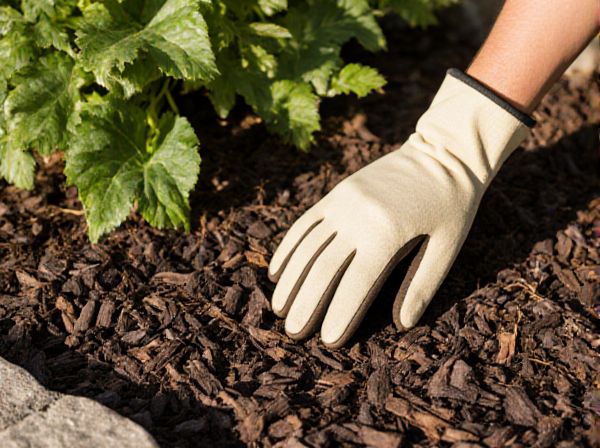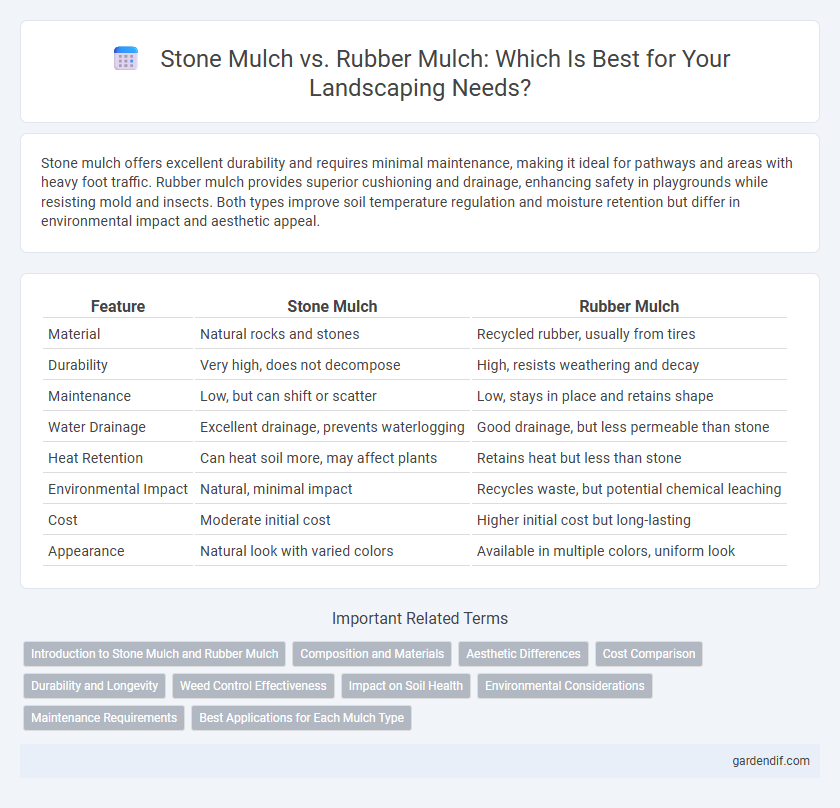
Stone mulch vs Rubber mulch Illustration
Stone mulch offers excellent durability and requires minimal maintenance, making it ideal for pathways and areas with heavy foot traffic. Rubber mulch provides superior cushioning and drainage, enhancing safety in playgrounds while resisting mold and insects. Both types improve soil temperature regulation and moisture retention but differ in environmental impact and aesthetic appeal.
Table of Comparison
| Feature | Stone Mulch | Rubber Mulch |
|---|---|---|
| Material | Natural rocks and stones | Recycled rubber, usually from tires |
| Durability | Very high, does not decompose | High, resists weathering and decay |
| Maintenance | Low, but can shift or scatter | Low, stays in place and retains shape |
| Water Drainage | Excellent drainage, prevents waterlogging | Good drainage, but less permeable than stone |
| Heat Retention | Can heat soil more, may affect plants | Retains heat but less than stone |
| Environmental Impact | Natural, minimal impact | Recycles waste, but potential chemical leaching |
| Cost | Moderate initial cost | Higher initial cost but long-lasting |
| Appearance | Natural look with varied colors | Available in multiple colors, uniform look |
Introduction to Stone Mulch and Rubber Mulch
Stone mulch consists of natural rocks like gravel, pebbles, or crushed stone that provide excellent durability and drainage for landscaping beds. Rubber mulch, made from recycled tires, offers long-lasting color retention and superior weed suppression without decomposing. Both options enhance soil temperature regulation and moisture retention but differ significantly in environmental impact and maintenance requirements.
Composition and Materials
Stone mulch consists of natural rocks such as granite, limestone, or river stones known for durability and excellent drainage properties. Rubber mulch is made from recycled tires, offering long-lasting cushioning and resistance to decomposition without attracting pests. Both materials provide distinct benefits in landscape design, with stone mulch excelling in moisture retention and rubber mulch enhancing shock absorption.
Aesthetic Differences
Stone mulch offers a natural, elegant appearance with various color options like river rock, slate, and granite, creating a sophisticated landscape design. Rubber mulch provides a consistent, vibrant color palette that resists fading, enhancing garden beds with long-lasting brightness. Stone mulch adds texture and weight, while rubber mulch delivers a softer, uniform look suitable for playgrounds and high-traffic areas.
Cost Comparison
Stone mulch typically costs between $3 and $5 per square foot, making it a more affordable option for long-term landscaping projects compared to rubber mulch, which ranges from $7 to $9 per square foot. While the initial investment for rubber mulch is higher, its durability and low maintenance may result in lower replacement costs over time. Evaluating the total cost of ownership, including installation and lifespan, reveals that stone mulch provides upfront savings, whereas rubber mulch offers cost efficiency in the long run.
Durability and Longevity
Stone mulch offers exceptional durability, resisting decay, weathering, and insect damage for decades, making it ideal for long-term landscaping projects. Rubber mulch, made from recycled tires, also provides impressive longevity, maintaining its color and shape for up to 10 years without decomposing. While stone mulch requires minimal replacement, rubber mulch benefits from flexibility and shock absorption, but may eventually deteriorate under extreme UV exposure.
Weed Control Effectiveness
Stone mulch provides superior weed control by creating a dense, impenetrable barrier that inhibits weed seeds from germinating and emerging. Rubber mulch, while effective in suppressing weed growth, tends to allow some weeds to penetrate due to its lighter weight and looser structure. Studies indicate stone mulch's higher durability and compactness result in longer-lasting weed control compared to rubber mulch.
Impact on Soil Health
Stone mulch provides excellent drainage and prevents soil erosion but can lead to soil compaction and reduced moisture retention, negatively affecting root growth. Rubber mulch, while durable and effective at weed suppression, does not biodegrade and can release harmful chemicals that disrupt soil microbial activity and nutrient cycling. Choosing between stone and rubber mulch requires balancing long-term soil health considerations with landscape maintenance goals.
Environmental Considerations
Stone mulch offers durability and minimal degradation, posing little risk of chemical leaching into soil or water sources, making it environmentally stable over time. Rubber mulch, often made from recycled tires, helps reduce landfill waste but can release harmful chemicals called volatile organic compounds (VOCs) as it breaks down, potentially impacting soil and groundwater quality. Choosing stone mulch minimizes ecological disruption due to its inert nature, while rubber mulch requires careful consideration of potential environmental contamination during prolonged exposure.
Maintenance Requirements
Stone mulch requires minimal maintenance, as it does not decompose or compact easily, allowing for long-term durability without frequent replacement. Rubber mulch also offers low maintenance due to its resistance to moisture, pests, and fading, but it may need occasional raking to maintain an even surface. Both mulches reduce weed growth effectively, but stone mulch requires less upkeep related to displacement or degradation compared to rubber mulch.
Best Applications for Each Mulch Type
Stone mulch excels in enhancing drainage and preventing soil erosion, making it ideal for rock gardens, pathways, and areas with heavy rainfall. Rubber mulch offers superior durability and weed control, perfect for playgrounds, landscaping around plants sensitive to soil moisture, and high-traffic areas. Both mulch types help regulate soil temperature, but stone mulch is preferred for heat-loving plants, while rubber mulch suits spaces requiring long-lasting, low-maintenance ground cover.
Stone mulch vs Rubber mulch Infographic

 gardendif.com
gardendif.com